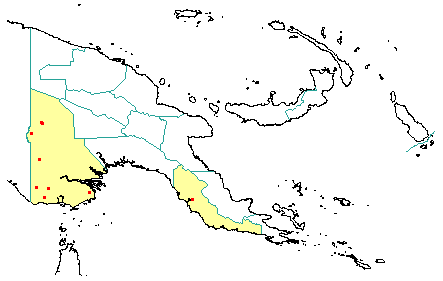
in PNGplants database
PNGTreesKey – Parinari nonda F.Muell. ex Benth. |
Barry Conn (NSW) & Kipiro Damas (LAE).
Guide to trees of Papua New Guinea
Copyright held by the authors, National Herbarium of New South Wales, and Papua New Guinea National Herbarium
Flora Australiensis Vol. 2: (1864)
Other Literature: G.T. Prance, Flora Malesiana, Series 1 658 (1989)
Family: Chrysobalanaceae
Dicotyledon
Timber Group: Non-timber species
Field Characters: Small sub-canopy tree (up to 15 m high, rarely to 24 m); Bole cylindrical (to slightly irregular, mostly up to 50 cm diam., often up to 120 cm); straight (bole up to 18 m long); buttresses buttresses present or buttresses absent; spines spines absent; aerial roots aerial roots absent; stilt roots stilt roots absent; Bark dark grey, brown, or almost black, slightly rough, slightly pustular or fissured, lenticels irregular; Subrhytidome (under-bark) dark red or brown; less than 25 mm thick, 9.0-15.0; bark blaze consisting of one layer; strongly aromatic or faintly to non-aromatic; pleasant; outer blaze red or brown, markings absent, granular without splinters; inner blaze red or brown, markings absent, granular without splinters; bark exudate (sap) present, colourless, not readily flowing (spotty), colour not changing on exposure to air, slightly sticky; terminal buds not enclosed by leaves.
Indumentum: Complex hairs absent; stinging hairs absent; mature twig indumentum (hairs) present or variable (pustular with lenticels plentiful), hairs dense (hairs reddish).
Leaves: Leaves spaced along branches, spiral (leaves occurring singly at a node and arranged spirally up the branchlet), simple (a leaf composed of a single blade); petiole present, not winged, attached to base of leaf blade, not swollen; leaves broadest at or near middle, broadest below middle, or slightly equally broad throughout much of length, 4.0-8.0 (-16.0) cm, (1.8-) 2.5-4.5 (-6.5) cm; symmetric, entire (with a pair of glands near base of margin), not dissected or lobed, rounded, sub acute, or mucronate (shortly (acumen up to 10 mm long), venation pinnate, secondary veins open, prominent, intramarginal veins absent; leaves lower surface pale green or grey (greenish with red-brown hairs), upper surface pale green, indumentum (hairs) present (on lower surface in stomatal pits), indumentum (hairs) dense; absent; domatia present (stomatal pits), scattered across lamina (); stipules absent.
Flowers: Inflorescence terminal (and subterminal), flowers on a branched axis, cones absent; flowers bisexual, stalked, flowers with many planes of symmetry, 3.0-5.0 mm long, diameter small (up to10 mm diam.) (3-4 mm diam.); perianth present, with distinct sepals and petals whorls, inner perianth white or cream-coloured; 5, free or some or partly joined (by misinterpretation: joined to top of hypanthium that is sometimes incorrectly regarded as a corolla tube); stamens 7-(with staminodes present)-9, present, free of each other or joined, free of the perianth or joined to the perianth (by misinterpretation: stamens joined to top of hypanthium, together with petals); ovary superior, carpels joined (when more than one), locules 2; styles solitary, 1.
Fruits: Infrutescence arranged on branched axis, fruit 30.0 (c.) mm long, 25.0 (c.) mm diam., brown, not spiny, slightly non-fleshy or fleshy, simple, indehiscent, drupe; seeds 1-(1 per locule)-2, about 10 mm long (c. 10 mm long), not winged, narrow (longer than wide), seed 1-10 mm diam. (5-6 mm diam.).
Distribution: Western or Central (possibly).
 | Botanical records in PNGplants database |
Notes: Notes The plants of this species that occur in Western Province (Papua New Guinea), are not readily distinct from Parinari papuana. Furthermore, they are somewhat different to the plants of this species that occur in Northern Australia. In Australia, Parinari nonda is a small tree (mostly less than 15 m high), with leaves having 10-17 pairs of secondary veins and with leaf apex acute or rounded, rarely acuminate and then mostly shortly so. In Papua New Guinea, there is a similar number of secondary vein-pairs but the leaf apex is shortly to strongly acuminate, more typical of P. papuana. For other differences refer to the notes under Parinari papuana.